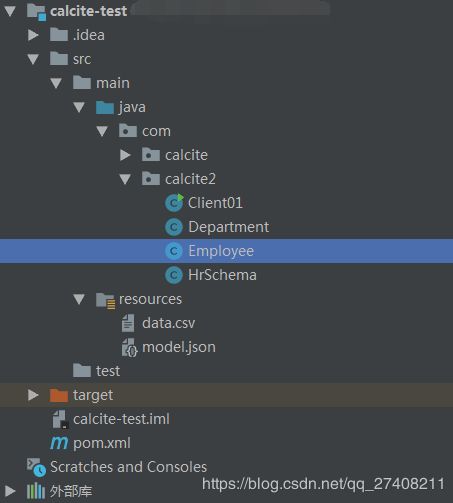apache calcite 进阶篇(一)
介绍
上一篇已经介绍过如何利用SQL解析查询出hello world,通过工厂模式实例化Scheam, schema包含表,表包含数据。没看过的可以去看https://blog.csdn.net/qq_27408211/article/details/86497097
用过工具的基本也都是这种形态。今天学习用不一样的方式也非常简单的代码实现复杂的SQL解析。
代码结构
pom.xml
4.0.0
com.calcite
calcite-test
1.0-SNAPSHOT
calcite-test
UTF-8
1.8
1.8
org.apache.calcite
calcite-core
1.18.0
讲解
相信大家都见过以下代码
这是一段连接jdbc数据的代码,需要在pom文件引入mysql驱动。换成calcite之后。变成
Client01.java
package com.calcite2;
import org.apache.calcite.adapter.java.ReflectiveSchema;
import org.apache.calcite.jdbc.CalciteConnection;
import org.apache.calcite.schema.SchemaPlus;
import java.sql.*;
public class Client01 {
/**
* // SchemaFactory factory = new ReflectiveSchema.Factory();
* // final ImmutableMap.Builder builder = ImmutableMap.builder();
* // builder.put("class","com.calcite2.FoodMart");
* // builder.put("staticMethod","instance");
* // Map operand = builder.build();
* // Schema schema = factory.create(rootSchema,"hr",operand);
* // rootSchema.add("hr",schema);
* */
public static void main(String[] args) throws ClassNotFoundException, SQLException {
Class.forName("org.apache.calcite.jdbc.Driver");
Connection connection = DriverManager.getConnection("jdbc:calcite:lex=JAVA");
CalciteConnection calciteConnection = connection.unwrap(CalciteConnection.class);
final SchemaPlus rootSchema = calciteConnection.getRootSchema();
rootSchema.add("hr", new ReflectiveSchema(new HrSchema()));
calciteConnection.setSchema("hr"); // 设置默认Schema
Statement statement = calciteConnection.createStatement();
ResultSet resultSet = statement.executeQuery(
"select d.deptno, min(e.empid) from hr.emps as e join hr.depts as d on e.deptno = d.deptno " +
"where e.deptno = 10 group by d.deptno having count(*) > 1");
ResultSetMetaData metaData = resultSet.getMetaData();
int columnCount = metaData.getColumnCount();
int lineIndex = 1;
while(resultSet.next()){
System.out.println("行序号 => " + lineIndex);
for (int i = 1; i < columnCount + 1; i++) {
Object value = resultSet.getObject(i);
System.out.println(String.format("\t列序号 => %s, 值 => %s, 类型 => %s", i,value,metaData.getColumnTypeName(i)));
}
lineIndex += 1;
}
resultSet.close();
statement.close();
connection.close();
}
}
以上代码着重点
上面的代码最重要的就是
new ReflectiveSchema(new HrSchema()) 这段代码可以看源代码是通过反射实例化Schema中的字段,设置hr数据库。
calciteConnection.setSchema("hr"); // 设置默认Schema,如果没有这句,每次写SQL都要指明hr.表名。HrSchema.java
没错,就是模拟两个表的之前的关系。数据结构如图
接下来我们的任务是 查出部门编号为10并且至少有1个员工部门编号和最小员工ID
Employee.java
package com.calcite2;
public class Employee {
public final int empid;
public final int deptno;
public final String name;
public final float salary;
public final Integer commission;
public Employee(int empid, int deptno, String name, float salary, Integer commission) {
this.empid = empid;
this.deptno = deptno;
this.name = name;
this.salary = salary;
this.commission = commission;
}
@Override public boolean equals(Object obj) {
return obj == this
|| obj instanceof Employee
&& empid == ((Employee) obj).empid;
}
public String toString() {
return "Employee [empid: " + empid + ", deptno: " + deptno
+ ", name: " + name + "]";
}
}
Department.java
package com.calcite2;
import java.util.List;
public class Department {
public final int deptno;
public final String name;
@org.apache.calcite.adapter.java.Array(component = Employee.class)
public final List employees;
public Department(int deptno, String name, List employees) {
this.deptno = deptno;
this.name = name;
this.employees = employees;
}
@Override public boolean equals(Object obj) {
return obj == this
|| obj instanceof Department
&& deptno == ((Department) obj).deptno;
}
public String toString() {
return "Department [deptno: " + deptno + ", name: " + name
+ ", employees: " + employees + "]";
}
}
一对多数据关系一定要加上@org.apache.calcite.adapter.java.Array(component = Employee.class) 这句,不然SQL会报空指针
如上代码就可以完成稍微复杂的关系查询了如:
select d.deptno, min(e.empid)
from
hr.emps as e
join
hr.depts as d
on e.deptno = d.deptno
where e.deptno = 10
group by d.deptno
having count(*) > 1两个表关联查询结果:






